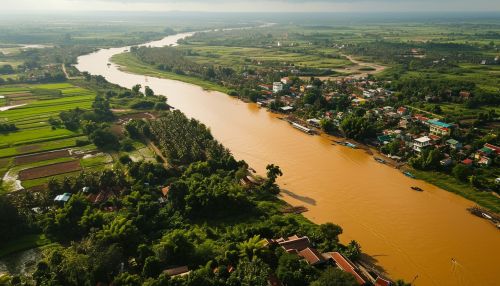Funan
History
Funan, also known as Nokor Phnom, was the name given by Chinese cartographers, geographers and writers to an ancient Indianised state—or, rather a loose network of states (Mandala)—located in mainland Southeast Asia centered around the Mekong Delta that existed from the first to sixth century CE. Mandala was a Southeast Asian political model that constituted the political organisation of these states. The people of Funan were known to the Chinese as "those who are in the East of the Kingdom of Funan".


The culture of Funan was a combination of indigenous cultures, and Indian and Chinese influences. This is evident in the archaeological evidence found throughout the region, including a variety of artefacts, architectural styles, and inscriptions. The influence of Indian culture was particularly strong, with the adoption of Sanskrit as the language of administration and the practice of Hinduism and Buddhism.
Geography
The Kingdom of Funan was located in the lower Mekong Delta region, in what is now southern Vietnam and Cambodia. The region is characterized by a flat terrain and a network of canals and rivers, which facilitated trade and communication. The capital of Funan, Vyadhapura, was located near the modern city of Phnom Penh. Other important cities included Oc Eo, Angkor Borei, and Thanh Hoa.
Economy
The economy of Funan was based on agriculture, trade, and craft production. Rice cultivation was the main agricultural activity, supported by a sophisticated system of irrigation and water management. Funan was also a major trading hub, with trade routes extending to India, China, and the Malay Archipelago. The people of Funan produced a variety of goods for trade, including gold, silver, copper, iron, ceramics, glass, and textiles.
Society and Culture
The society of Funan was hierarchical, with a king at the top, followed by nobles, officials, commoners, and slaves. The king was considered a divine ruler, and his authority was legitimized by Hindu and Buddhist religious beliefs. The people of Funan practiced a combination of Hinduism, Buddhism, and indigenous animistic beliefs. They built temples and shrines dedicated to various deities, and performed rituals and ceremonies to honor them.
The culture of Funan was heavily influenced by Indian culture, as evidenced by the use of Sanskrit, the adoption of Indian religious practices, and the Indian style of art and architecture. However, the people of Funan also maintained their indigenous cultural traditions, and their culture was a unique blend of indigenous, Indian, and Chinese elements.
Decline and Legacy
The decline of Funan began in the 6th century CE, when it was invaded by the Chenla Kingdom. The last known king of Funan, Rudravarman, was defeated by the Chenla king, Bhavavarman I. After the fall of Funan, the region was incorporated into the Chenla Kingdom, and later became part of the Khmer Empire.
The legacy of Funan is evident in the cultural and historical heritage of Southeast Asia. The Indianised culture of Funan laid the foundation for the development of the classical cultures of Southeast Asia, including the Khmer, Mon, and Cham cultures. The archaeological sites and artefacts of Funan provide valuable insights into the history and culture of ancient Southeast Asia.
